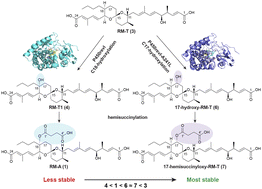Reveromycin A (RM-A) (1) has a 6,6-spiroacetal core structure that is important for its biological activity. However, 1 undergoes a spiroacetal rearrangement to form RM-B (2) with a 5,6-spiroacetal core, which exhibits reduced bioactivity. This undesired rearrangement is partly due to the hemisuccinate moiety at the C18 position of 1. In 1 biosynthesis, P450revI catalyses the C18-hydroxylation of RM-T (3), which is essential for its subsequent hemisuccinylation to generate 1. In this study, we aimed to alter the P450revI regioselectivity to improve the stability of the 6,6-spiroacetal core and expand the structural diversity of RMs. Candidate amino acid residues for mutagenesis studies were selected by comparing the co-crystal structure of P450revI with the docking models of the P450revI mutant-3 complexes. Notably, the P450revI-A241L mutant selectively produced novel RM derivatives. Nuclear magnetic resonance analysis revealed that P450revI-A241L catalysed the C17-hydroxylation of 3 to produce 17-hydroxy-RM-T (6). Co-crystal structure analysis of the P450revI-A241L-3 complex revealed that the pro-R hydrogen at the C17 position faces toward the haem iron. Introduction of the P450revI-A241L mutant gene into the Actinacidiphila reveromycinica SN-593-ΔrevI strain led to the production of 17-hemisuccinyloxy-RM-T (7). After the successful bioproduction of RM derivatives, we evaluated their structural stabilities and biological activities. Compounds 6 and 7 exhibited better stabilities than 18-hydroxylated-3 (RM-T1; 4) and 1, respectively. Biological activity analysis revealed that 6 and 7 exhibited anti-malarial and anti-multiple myeloma activities, respectively, comparable to those of 1 and 3, while showing low cytotoxicity against human cell lines. Overall, this study highlights the potential of RM derivatives as pharmaceuticals.


